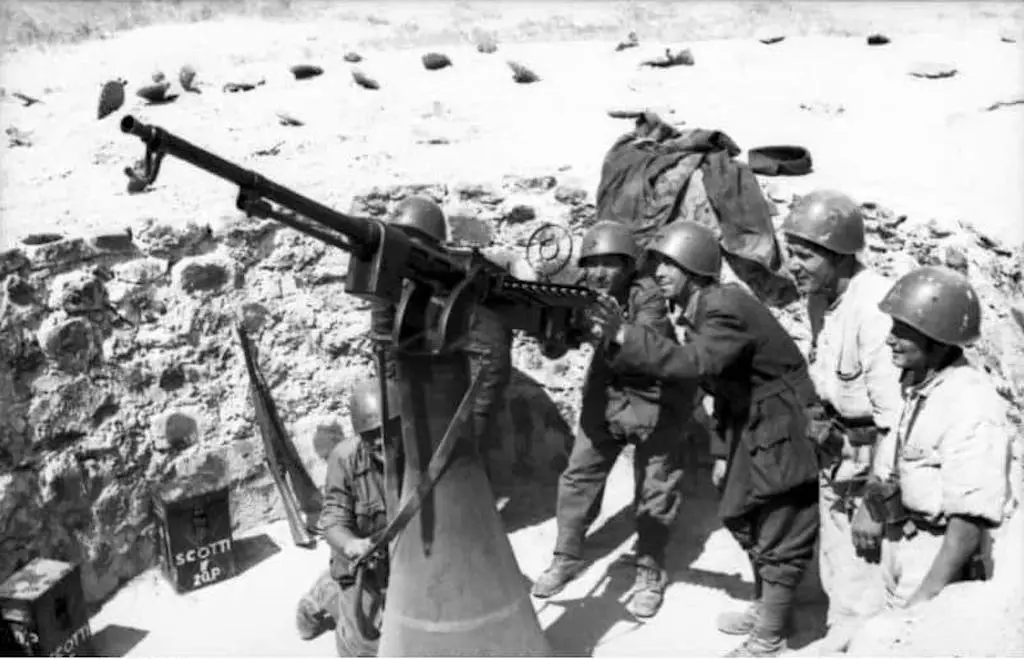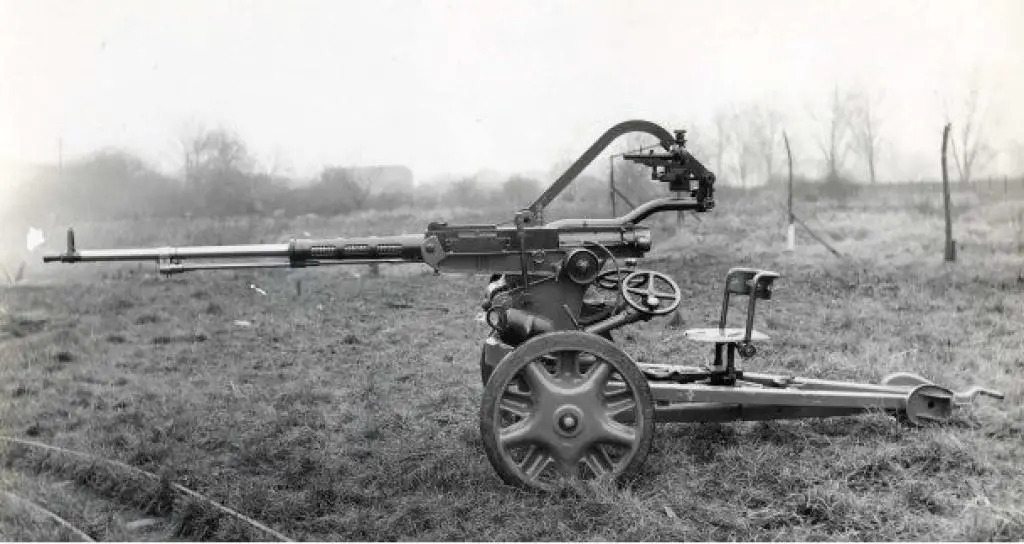Background on the Scotti Cannone-Mitragliera da 20/77
During the Second World War, the Italian armed forces employed two light, 20 mm antiaircraft guns. The first and more popular of the two was the Cannone-Mitragliera da 20/65 modello 35 (Breda). The second was the Cannone-Mitragliera da 20/77 (Scotti), which saw much lower production numbers. Both were automatic cannons, capable of engaging aircraft or land targets. The 20 mm Scotti derived its name from the creator, Alfredo Scotti. Another name for the same gun was Cannone-Mitragliera Isotta Fraschini, after the manufacturer, Isotta Fraschini.

Scotti Cannone-Mitragliera da 20-77 on a pedestal mount. Image Credit: Bundesarchiv Bild
In the run-up to the Second World War, Italy commissioned several new weapon designs. Of these, Alfredo Scotti designed the 20 mm Scotti in 1932. Swiss manufacturer, Oerlikon handled initial manufacturing of the Cannone-Mitragliera da 20/77. The cannon had many similarities to the famous 20 mm Oerlikon, which is still used in service around the world. Compared to the Oerlikon gun, the Scotti initially shared its 60 round drum but was overall a simpler design. The Scotti utilized a different firing mechanism, and the guns became further distinguished after the Italians discarded the 60 round drum.
Scotti da 20/77 vs. Breda da 20/65
In active use, Italian troops provided 12 round trays for the Scotti and the Breda. Additionally, both guns used similar ammunition types. However, the 20mm Scotti’s maximum firing range measured only 2.1 km compared to the 2.5 km range of the Breda. Additionally, the Breda’s muzzle velocity was slightly higher, at 840 m/s to 830.
This seems strange at a glance, as the Scotti had a much longer barrel than the Breda. Their 20/77 and 20/65 designations refer to the length of the gun barrel, which serves to increase range. From the comparatively low muzzle velocity, you can draw that the Scotti used ammunition with a lighter propellant charge. However, both had similar utility against armored units at normal combat ranges. Both guns could penetrate up to 30 mm of armor, out to about 500 yards. Owing to their range and rate of fire, they became quite dangerous for light tanks and thin-skinned vehicles.
You May Also Like: Breda Model 35 Anti-Aircraft Gun
Advantages of the Scotti
Despite the overall inferior performance, the Scotti had several practical advantages of value to Italy. The rate of fire was slightly faster, 10 rpm higher than the Breda at 250 rpm. A faster-firing gun is more forgiving and effective in deterring air attacks when the gun itself is targeted. Additionally, the Scotti was significantly lighter, only weighing 227.5 kg. The Breda, at 330 kg, was less easy to transport. Deploying the Scotti requires few men and little time, and it would be quite suitable for fighting in the mountains. It enjoyed a traverse of -10/+85, which would let it engage ground targets more effectively than most light antiair guns. Many antiair guns, such as the Breda 20mm lacked any downward traverse.
Perhaps he greatest advantage of the Scotti was its simplicity; it was extremely cheap to produce. Despite the strains of war and Allied bombing, production totals for the Scotti increased through 1942. However, the Breda was much more numerous among the Italian armed forces throughout the war. There’s also no indication that the Regia Marina used the Scotti on their ships. In comparison, the Breda and Oerlikon both saw naval usage.

The Scotti on a two-wheel carriage.
Two versions of the 20mm Scotti existed. One which was suitable for stationary emplacements, and deployed in mainland Italy and coastal fortifications for static defense. The second was semi-mobile and could be truck-towed on a carriage, or carried in a truck bed. In practice, the Italian two-wheeled carriages suffered a faulty design that limited speed to 20km/h. As such, the Scotti was generally carried on a truck bed, removed by hand and positioned manually.
Cannone-Mitragliera da 20/77 in Italy and Abroad
Besides use in the wartime Italian military, the Scotti found its way around the world. The simplicity of production made it cheap and appealing to South American nations, and it also saw use in China. German forces designated it the 20mm Scotti (i) and used it in North Africa alongside Italian forces.
After the Italian collapse in 1943, Germany requisitioned large numbers of Scotti cannons from disarmed Italian units. Hungary, Slovakia and other Axis allies often received such captured weapons from Germany. German forces in Yugoslavia used captured Scotti’s against partisans, and the British actually employed the captured guns. Significant numbers bolstered the protection of Allied coastal artillery installations in Italy, after 1943. Finally, the 20mm Scotti would continue to see use in the post-war Italian military.
Specifications
| Model | Scotti da 20/77 |
|---|---|
| Caliber | 20 mm |
| Muzzle Velocity | 2,723 fps (830 mps) |
| Length | 60.6 inches (1.54 m) |
| Traverse | 360° |
| Weight in Action | 502 lb (227.5 kg) |
| Projectile Weight | 0.276 lb (0.125 kg) |
| Rate of Fire | 250 RPM |
| Maximum Range | 7,005 ft (2,135 m) |
